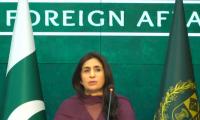Over the past 32 months, the PTI government has spent Rs10 trillion more than the government’s income. That’s the budgetary deficit. The budgetary deficit was filled by high cost loans. That’s digging deeper into the debt trap. Over the past 32 months, the circular debt in the electricity sector has gone up from Rs1.1 trillion to Rs2.5 trillion. This Rs1.4 trillion loss has to be filled by high cost loans. That’s digging even deeper into the debt trap.
Public Sector Enterprises have taken Rs2,000 billion worth of debt. The circular debt in the gas sector now exceeds Rs350 billion. The government’s so-called ‘Commodity Operations’ have taken Rs700 billion worth of additional debt. Lo and behold, the Federal Board of Revenue (FBR) has also accumulated Rs710 billion worth of circular debt in the form of ‘tax refunds’. Ever wondered why we are in a debt trap?
Then there’s the external front. Imagine; a country of 220 million got foreign investment of $1.3 billion (Jul-Feb) down 30 percent from an already low base of last year (India attracted $72 billion during April-January up 15 percent from last year). Pakistan then went for debt-creating dollar inflows. Lo and behold, Pakistan’s gross external financing requirement this year exceeds a colossal $30 billion. That’s digging even deeper into the debt trap.
Let us all welcome the IMF, the international lender of last resort. The IMF tells us two things: increase taxation and tighten up the monetary policy (read: increase interest rates). To be certain, increased taxation and a restrictive monetary policy only means low growth. Lo and behold, low growth takes us deeper into the debt trap. That’s the classic vicious cycle – a “sequence of reciprocal cause and effect in which two or more elements intensify and aggravate each other, leading inexorably to a worsening of the situation.” Yes, low growth means digging even deeper into the debt trap.
The IMF’s prescriptions – higher taxation and a tight monetary policy – shall push us even deeper into the debt trap. The IMF’s prescriptions curtail demand. In order to grow out of the debt trap we need to increase demand. Yes, there’s only one way to get out of this debt trap: to grow out of the debt trap. And, in order to grow out of the debt trap we must do two things: fiscal consolidation and structural reforms. Fiscal consolidation is defined as “concrete policies aimed at reducing government deficits and debt accumulation.” The consequence of fiscal consolidation is growth – and growth will take us out of the debt trap we are in.
With or without the IMF, we urgently need a credible fiscal consolidation plan (which in turn will boost market confidence and lead us into the growth phase). With or without the IMF, we urgently need to undertake structural reforms. The consequence of structural reforms is growth-and growth will take us out of the debt trap we are in.
Red alert: Pakistan’s economic disequilibria is spiralling out of control. For a credible fiscal consolidation plan Pakistan needs a credible team. And that’s the most unfortunate part of the Pakistan story – 50 percent of the PTI’s time is over and the PTI is yet to put together a credible team. Remember, “Modern slaves are not in chains; they are in debt.”
The writer is a columnist based in Islamabad.
Email: farrukh15@hotmail.com Twitter: @saleemfarrukh
A woman walks past a building of the International Monetary Fund. — AFP/FileThe annual and spring meetings of the...
Late Benazir Bhutto's daughter Asifa Bhutto Zardari addresses the Christian community in Bihar Colony on January 23,...
Representational image. — PexelsWater is an important scarce natural resource that is required for several everyday...
Pakistani employees of online marketplace company Kaymu at work in Karachi. — AFP/FileThe true spirit of development...
India uses Afghanistan as a backstage area to carry out terrorist attacks against Pakistan
Another report by the Pakistan Institute of Peace Studies states that 78 per cent of attacks have been carried out by...







